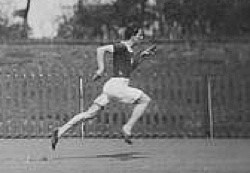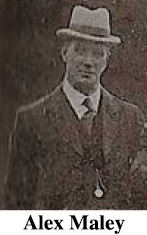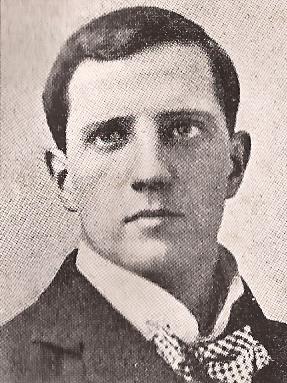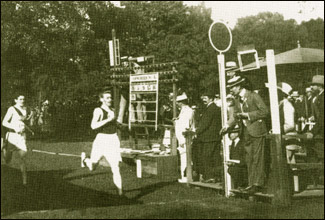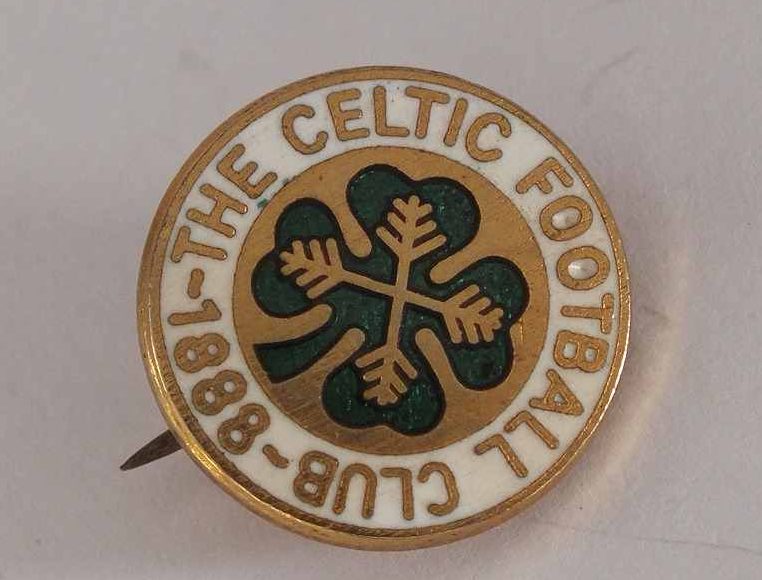AR Downer.
“There will be no Irish competitors at the Celtic Sports on Saturday but it is just possible that one or two prominent Irish athletes may figure in the flat events. They of course run the risk of disqualification if they compete under the rules of an alien Union, but that would seem to have little or no terror for them. The Celtic, as is well known, have a powerful influence on Irish athletic circles, and from the temperament of the people across the channel all the restrictions in the world will not prevent the men from competing if they make up their mind to do so, and can find the time to travel to Scotland. What influence the absence of the English party, whose presence has always been a commanding feature of the Celtic sports, will have on the attendance remains to be seen.” Yes indeed, runners like Bradley and Bacon were undoubtedly big attractions and also added a lot to the Scottish scene generally and they would not come to the SAAU rules Celtic sports.
Before we go on with the account of the Celtic Sports in 1895, we should maybe look at some Scottish athletics history. The top club in any sport, whether it be football, athletics or any other will be the subject of criticism and at times unfair discrimination. In 1895 Clydesdale Harriers was the strongest club in athletics and Celtic was one of the strongest in football. The Scottish Amateur Athletic Association was in dispute with the Scottish Cyclists Union which was allied to Clydesdale Harriers. One thing led to another and Clydesdale broke away from the SAAA. With powerful members of Celtic also members or former members of Clydesdale, eg the Maley brothers, PJ Gallagher, etc, the club left the SAAA and joined the Union. With the SAAA allied with the AAA in England and the IAAA in Ireland, it meant that no athlete of any club affiliated with these bodies could run at SAAU events without being disciplined by their governing body. Celtic were outside the SAAA pale and had cast their lot with the SAAU. Back to Scotland in 1895.
All the talent that the SAAU can boast will be at Parkhead on Saturday.” So said the Glasgow Herald of 6/8/95. Whether they did or not, the meeting was a great success. The ‘Scottish Referee’ of 12th August reported:
£440! This magnificent sum was drawn by the Celts at their sports meeting on Saturday. This total must be as much a source of joy to the Celtic as it must be the envy of other clubs. We said on Friday that the Celtic could draw admiring throngs even without the aid of Bradley, Bacon and co., and the monster attendance is proof of our estimate of their loyal patrons. It must be particularly gratifying to the Celts that whereas other clubs can barely make both ends meet they can do so with ease and leave a handsome balance to carry forward. Enterprise such as the Celtic have shown in enlarging and improving their model enclosure deserved success, and none will grudge them the reward that has now attended their labours. “
As far as the athletics was concerned, there was nothing really remarkable other than the revival of the steeplechase and after the interest and amusement it created on Saturday, it is certain to be an annual institution at Parkhead.” With an attendance of 20,000 lined round and round the arena, the events on the programme included 120 yards handicap invitation, 100 yards flat race (10 heats and three semi finals), 220 yards (8 heats), 440 yards (4 heats), one mile, and mile steeplechase handicap (29 ran). They were all good, close, club standard races and the point of the steeplechase seemed to be entertainment with one comment being that there were not enough water jumps. There were also a number of cycle races in which RA Vogt had entered as Celtic FC!
The Maley brothers were all famous athletes – Tom was maybe the most naturally talented, Willie worked hard for the successes he got, and AS was a regular competitor in the sprints at the Sports meetings round the country. Alex Maley was the third of the Maley brothers who all became football managers – he was manager of Clyde, Clydebank, Hibs and Crystal Palace, and Tom at Manchester City, Bradford Park Avenue and assisted at Southport.
1896 was to be Willie’s year – even if he had been a team manager for several years. There were two Scottish championships in 1896 and Willie ran in the SAAU version at Hampden on 27th June. His form coming in to the championships was not of the best but on the day he emerged triumphant as SAAU Scottish 100 yards champion with a winning time of 11 seconds.
In August however his mind was on the club sports meeting. The weekend before, on the weekend of Rangers Sports, the Celtic manager was nowhere to be seen. The ‘Referee’ remarked, “Secretary W Maley was at Brig o’ Allan negotiating talent for the 15th while AS Maley busied himself in the ring at Ibrox booking entrants for Saturday first.”
When the day came there was a sight seldom seen at any sports meeting: the team manager running in the competition and even winning a prize from a low mark. Willie Maley was second (scratch) in the first heat of the invitation 100 yards and second in the final, beaten by JB Auld (1 yard) with the first 4 all very close across the line. Winning time was 10.8 seconds. The One Mile handicap was won by G Graham (CH – 75 yards) from JS Duffus (CH – 50 yards) in 4:23.8. In the open 100 yards there were 20 heats with AS Maley (off 4 yards) winning the 11th heat but not progressing to the final. It was won by T Frew (Vale of Avon – 5 yards) in 10.6. There was a Great Novelty Race – This race was between D McFarlane, cyclist, and S Duffus, four miles champion, and W Robertson, one mile champion, foot runners. The cyclist, who was paced by tandems, had to cover five miles or 3800 yards, and the foot runners about 2 1/2 miles or 4310 yards. The race afforded considerable interest to the crowd. McFarlane, who smashed Vogt and Crawford’s records from two hours to five miles, won the prize.
There was a two miles steeplechase: “The competitors with the exception of Blews fought shy of the ditch. Judge Allison of St Mirren decided to award Mr Blews, Kirkcaldy FC, 250 yards, who finished third, the prize with the other two prizes to be retained by Celtic. Blews, without exception, cleared the hurdle and the ditch fearlessly every time. His time was 12 min 25 sec.”
The 300 yards was won by CF Meikle, Partick Thistle, who was a regular competitor at the various sports meetings. And finally, Conneff, the American champion, one mile flat race, ran an exhibition race, and was accompanied by Mullen. The event fell flat and the time was bad.”
It was a good meeting but again there was evidence of the continuing series of innovations by the club – the novelty race, the steeplechase and the invitation race. The spirit would continue into the Monday meeting too.
After the main sports meeting on Saturday, there was the Monday supplementary meeting. The ‘Glasgow Herald’ said “Celtic hold a supplementary meeting this evening when another interesting programme will be submitted. Instead of a 100 yards sprint there is one over 130 yards . This distance is more popular in the East than in the West but the race tonight should reveal that such men as Bell, Auld, Shanley, Mitchell and others who improve the further they go, at their best. There is an entry of 66 for this race and, except in the case of W Maley and Auld who start at scratch and 1 yard respectively, as in the shorter sprint, the principle of gradation has been carefully applied all round. Another Interesting feature is the introduction of a high jump handicap, and the fact that eleven entries have been received clearly shows that this and other miscellaneous athletic events only require such encouragement as the Celts are exhibiting tonight to gain in popularity, and develop results that will in the end add to our national prestige. ”
The article went on to say that there would also be a two miles handicap with A Hannah (CH) and J Lamb (Edinburgh) competing, plus a series of cycle races. The meeting on 10th August attracted 4000 spectators on a fine night, a;lthough the programme was said by the Herald to be a lengthy one. What was there on it? There was an open handicap 120 yards with 12 Heats: AS Maley, off 6 1/2 yards won the 9th heat and Willie Maley (scratch) tied with J Darque and in the run-off, Maley was the one to go to the final where he was unplaced, the winner being Cordner of Glenboig FC. The open handicap high jump saw a Maryhill Harriers 1-2: the winner was J Gillan from J McFarlane. The two miles flat race handicap was won by the scratch man, JJ Mullen of Elysian AC, from W Robertson of Clydesdale Harriers, also off scratch, in 9:44.6. The two ran together to the final straight when Mullen ‘shot to the front’ and won by 5 yards. Mullen was four times Irish AAA Mile champion between 1893 and 1896 and once GAA mile champion plus IAAA four miles champion in 1890 and five miles in 1896. There were three cycle races.
There was also notice of a professional cycle and athletic meeting the following Saturday ‘on a large scale.’
Alf Downer, Scottish Pelicans
Negotiations had been going on between the SAAA and the SAAU over the weeks and months since the split and agreement between the two was reached in the SFA Rooms at Carlton Place in Glasgow on 23rd April, 1897. New laws and rules were issued defining what was an ‘amateur’ as had been accepted in Leeds in February 1896 between AAA, SAAA, and Irish AAA. Summer 1987 saw the two factions again competing under the single umbrella of the SAAA. The SAAU cause was probably helped by the fact that the major clubs in athletics and football were united in opposition to the SAAA.
On 9th August, 1897, Scottish Referee said “W Maley was at Newcastle on Saturday looking for talent and secured not a few stars.” The Glasgow Herald, also of 9th August, started its preview of the event
The sports were on Saturday, 14th August in 1897. as follows. “Everything the Celtic do, they do well; there are no half measures with them. Since the institution of their sports it has been a rule with them to introduce eminent athletes from England and Ireland . Bradley, Bacon, Perry, Wittenberg and Kibblewhite, an others of less note, have all helped to throw lustre over meetings at Parkhead from time to time, and though the amateurs of the present day are made of different stuff from these men, there are several who stand high in public favour, one or two of whom we are to have the pleasure of seeing on Saturday first.” It went on to name some of them, starting by saying that Bradley was not a certain starter, FW Cooper ( superb sprinter and Welsh rugby international), W Elliott, AAA quarter mile champion would run in the 300 yards, and W Tysoe would turn out in the 1000 and mile handicaps. They had invited 12 to 15 men to take part in the mile, including the three prize winners from the Rangers Sports the previous Saturday.
After these comments and the big build up, came the day and the Herald said: ” Expectation in the case of the English runners who took part in the sports of the Celtic Football Club was scarcely realised. The fact is that both A Tysoe and JW Bradley were most disappointing, and their failure to rise to the dignity of their reputation is the only regrettable feature in connection with Saturday’s function which in other respects was one of the most interesting in the club’s history.
Tysoe’s running in the 1000 yards was indeed poor and the final was won by Jackson of Maryhill Harriers, and the same script was followed in the Mile with Jackson winning and Tysoe disappointing. There were 20 heats, 4 semi finals and a final in the 100 yards which was eventually won by A Cairney of St Gerard’s off 4 1/2 yards. The 300 yards had nine heats and a final. There were 3000 spectators at the Monday supplementary meeting to see the 120 yards open handicap where after 12 heats, a second round and into the final, AS Maley was nowhere in the final which was won by Celtic FC’s T Moore. The two mile flat race was won by T McMillan of Stirling off a mark of 200 yards. Both meetings (Saturday and Monday) had several cycle races on the programme.
Alf Tysoe winning the Olympic 800m, Paris 1900
The report of the meeting was in the ‘Glasgow Herald’ of 1st August 1898 . That means that the sports had been held on 29th June when the usual date had become the second Saturday in August. How so? Well, the second Saturday of August had always been pretty near the start of the football season and most years there were friendlies and trials being played by the clubs of whatever standard. This could at times make life difficult for any event taking place from the middle of August on. It would eventually mean the death of the Celtic Sports. In 1898 the season did start on the second Saturday and Celtic, reluctant to miss a year, and not wanting to hold them on the same day as Rangers Sports, went back two weeks from their normal date. Not being at home on the second Saturday, they held the Scottish 50 mile cycling championship at Parkhead that day. Hence the end of June for the sports. The meeting however was a good one – particularly for the flat racing, as reported in the ‘Scottish Referee’.
“Though blessed with ideal sports weather, it cannot be said that the Celts’ crowd answered to it or to the excellent programme provided. By three o’clock the vast terraces and stands were very sparsely occupied. In another half hour, however, they assumed a cheerier look, and so did the countenances of the officials. If not up to expectations, the gate in comparison with that of other sports was very goodand we doubt not that the Celts are duly thankful for their success. …
“We had no crawls from the cyclists, no ‘hanging back from the athletes. Caldow, a champion come but yet coming, and Goodman, Gascoyne set the crawlers an example they would do well to imitate always. For the athletes, Messrs Cooper, Wadsley, Auld, Tysoe, and MacKenzie all ran to the death. As a result the public were immensely pleased with the afternoon’s sport. So much so that had Celtic, as usual, ventured upon an evening meeting tonight, they would have the satisfaction of having the public with them.”
The meeting was a success and the papers would be talking about it two and three weeks later when the football season had started up. The race of a meeting full of good racing with close finishes was the half mile with Tysoee against the AAA’s champion Relf. They ran together, passing Robertson of Clydesdale who was the best of the rest, before Relf gave nest 80 yards out leaving Tysoe to run on and win if he could. His time off 7 yards was 1:57.1 (against 1:57.8 a week earlier from scratch at Powderhall.) The winner however was Gudgeon of Ayr United. Apparently Tysoe tried to come through on the inside but there was a lot of jostling and he eventually fought his way clear when, according to the reports, had he just gone round his man he would have won the race. He redeemed his poor running of two years previously. The 120 yards was another very good race with all five finalists very close at the finish, JB Auld of Ayr FC, a regular finalist at these meetings, winning from 3 1/2 yards from Cooper of England (scratch) in 11 3/5th. Other events included a 220 yards (won by Kerley of Dublin), half mile (won by J McKenzie of Dublin – 25 yards), One Mile won by S Young of Paisley (115 yards) and several field events. Horgan of Ireland gave a demonstration of shot putting and created a new Scottish record of 46′ 8″, in the high jump Leahy who had cleared 6′ 4″ the week before only managed 5′ 11″and was easily defeated in the handicap. Caldow and Gascoyne starred in the cycle races.
Denis Horgan won a total 42 shot put titles during his athletic career, including 28 Irish championships, 13 English championships (all for the 16 pound shot) and one American championship. Horgan was “usually so superior to his fellow competitors that he seldom trained in any sort of systematic way, yet he showed a marked consistency of performance, in all conditions, over a period of twenty years. [from his Wikipedia entry}
All in all a good quality meeting, a variety of events and everybody happy yet again at a Celtic Sports meeting.
In 1899, 12th August was the dat, the club returning to its regular place in the calendar. The ‘Glasgow Herald’ said:
“If records did not fall on Saturday at Parkhead like grouse on a Highland moor, the excellence of the sport was such as has not been equalled at any athletic function in Glasgow this season. Nor is this surprising when the eminence of some of the competitors is taken into account. Hitherto the Celts have culled from the rich athletic stores of England, but this season Mr William Maley has directed his attention to the not less wealthy resources of Ireland, several of whose more distinguished athletes accepted the invitation, and their presence more than anything else contributed so largely to the success of Saturday’s meeting. If there is any place in Scotland where those of Irish nationality are warmly received it is at Parkhead, which overflows with a kind of exile enthusiasm, making Irishmen feel thoroughly at home and inspiring them to lofty achievements.”
Denis Horgan of Banteer in the shot, Kiely of Carrick-on-Suir in the hammer and hurdles and Leahy in the high jump were all mentioned with Horgan setting a new .Scottish record of 47′ 1″ and Kiely doing like wise with 149′. The half-mile was won by J McCafferty, sometimes known as P McCafferty who won the Scottish cross-country championship and then ran for Ireland in the international. The Mile was said to be an interesting race with the winner being Clydesdale’s JC Lindsay although Clydebank’s A McDonald was jostled in the finishing straight when he looked like the winner and could only finish second, one place in front of McCafferty. The other races including the cycling events were close finishes but not up to the standard of those mentioned above. All round, it was a good meeting to end the millennium.
